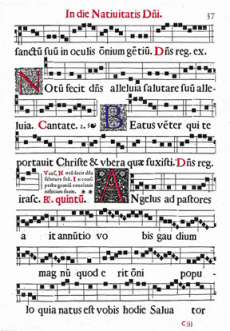Chant in the News
by Gary D. Penkala
Bringing Chant Back
In the La Crosse (WI) Tribune, KJ Lang writes:

Lorraine Riedl said her kids think it's "kind of weird" their mom likes Gregorian chanting.
But the beautiful sounds of Ave Maria — a Gregorian chant version — she sang in high school choir still linger in her head today while she does dishes or laundry at home.
"I think it's the timeless quality it has," she said.
It drew her to a Gregorian chant workshop at the Shrine of Our Lady of Guadalupe, a partnership between the shrine and the Diocese of La Crosse.
The deep, resounding tones of about 70 people led by conductor Scott Turkington through Kyrie eleison rang in a basement room of the shrine. Gregorian chant is a single line of melody sung in Latin to a liturgical text.
"It's hard for our modern ears because we always want more — more singers, more microphones," said Turkington, of Charleston, SC.
"In Gregorian chant you want less, less, less."
Because it has no instrumental accompaniment or harmonies, one would think Gregorian chant is simple.
But the square notes, four-lined staff and many notes for each syllable are a clue it takes some work to learn.
Participants included church organists, choir members, choir directors and the simply curious.
Kyle and Sandy Eller came from Saint Benedict Catholic Church in Duluth.
Like other Catholic churches, theirs is experiencing a resurgence of the historic tradition of Gregorian chant, they said.
Sandy, the church's music director, said she was "so totally pumped" about encountering the "beautiful treasure of 1,000-year-old music."
"I'm always a little surprised by all the little places it is cropping up," Kyle said.
Greg Marco, pilgrimage coordinator for the shrine, said, "The renewed interest in Gregorian chant has come in the past 10 to 15 years."
"Pope John Paul II and Pope Benedict XVI have been more adamant about having the sense of tradition within the liturgy," he said.
Chant and the Popes Benedict
Father Uwe Michael Lang, consultor for the Office of Liturgical Celebrations of the Supreme Pontiff and official of the Vatican Congregation for Divine Worship and the Sacraments, recalled the pronouncements of two popes named Benedict recently at the L'Accademia Urbana delle Arti in Rome.
In the 1749 encyclical Annus qui by Pope Benedict XIV, perhaps the "most important papal pronouncement on sacred music" prior to Pope Saint Pius X's Tra le sollecitudini, the pope "proposes the important criteria of sacred music that are valid beyond the limits of their historical context and resound also in our time."
The encyclical presents chant as normative for the Roman liturgy "while it approves unaccompanied polyphony and also permits orchestral music, though with certain conditions, in divine worship."
"The pre-eminence of chant," Father Lang further recalled, "was confirmed by Pope Benedict XVI in his 2007 post-synodal apostolic exhortation Sacramentum caritatis."
Father Lang proposed that the value of Gregorian chant is "its profound relationship with the liturgical text, to which it gives musical form." He added that though "sacred music cannot be limited exclusively to Gregorian chant, it has in itself, however, the keys for a true renewal of sacred music."
Chant as Our Prayer at Mass
From The Catholic Herald, newspaper of the Diocese of Madison (WI), we read in Bishop Robert C. Morlino's column:
I find myself almost forced to mention the workshop on Gregorian chant which the diocese sponsored last Friday night and Saturday morning.
For me it was one of those benchmark events since I have been in the Diocese of Madison.
Easily over 80 people were in attendance — we were almost too large a group for the venue to which we were assigned — and the presentations by Fr. Robert Skeris, of the Archdiocese of Milwaukee, a master presenter and scholar in the area of Church music, were both profound and excellent.
His enthusiasm stirred a great deal of enthusiasm among those present.
And after about two and a half hours of practice, those present were able beautifully to sing the whole Mass (Novus Ordo) in Latin, using Gregorian chant.
The beauty of this kind of prayer impressed itself on all of us who were there and made the Church's preference for Gregorian chant seem much more reasonable, and the chant itself seem much more "doable."
When we think of Gregorian chant as our prayer at Mass, not something that somehow accompanies our prayer but which embodies in sound the prayer itself, we start to think very differently about Church music in general.
This is certainly part of the renewal of the liturgy that we are seeking to accomplish in preparation for the First Sunday of Advent 2011, when we will begin to use the new English Translations of the Roman Missal, but it is also to recover the kind of sacramental attitude with which all of us should approach our full, active, and fruitful participation in the liturgy.
Much more needs to be said about this, and indeed, much more will be said about it in the days ahead.
|


